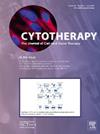利用搅拌槽生物反应器从多能干细胞中大规模生产造血干细胞和小胶质细胞,用于一致的细胞治疗制造
IF 3.2
3区 医学
Q2 BIOTECHNOLOGY & APPLIED MICROBIOLOGY
引用次数: 0
摘要
造血干细胞(hsc)和小胶质细胞对血液、免疫和中枢神经系统(CNS)的发育至关重要,为细胞治疗和神经退行性疾病治疗提供了巨大的潜力。然而,由于复杂的分化过程,从人类诱导多能干细胞(hiPSCs)中产生具有一致质量和可扩展性的这些细胞仍然具有挑战性。Ncardia开发了强大的方案,可以使用搅拌槽生物反应器进行大批量、可扩展的造血干细胞和小胶质细胞分化。我们成功地将小规模的2D贴壁分化转移到250mL的搅拌槽生物反应器中,目标是扩大到1L和3L系统。采用实验设计(DoE)方法对溶解氧、搅拌速度和接种密度等关键工艺参数进行优化。并行协议测试和进程内监控,由数据驱动分析支持,实现了快速优化和高再现性。结果我们的方案生成了高质量的造血干细胞和具有关键功能特性的小胶质细胞。hipsc衍生的造血干细胞表现出典型的形态,表达必要的标志物(90%为CD34、CD45、CD43),并分化为多种免疫细胞系,如NK细胞、巨噬细胞和小胶质细胞,增强了它们的细胞治疗潜力。同样,Ncyte®Microglia表达核心标记物(>80% IBA1, TMEM119, CX3CR1),并在炎症刺激下表现出吞噬和细胞因子分泌等功能能力。它们与神经元共培养的能力进一步增强了它们在药物发现和毒性测试中的应用。通过将干细胞生物学的专业知识与先进的生物反应器技术相结合,Ncardia能够大规模、高质量地生产造血干细胞和小胶质细胞。这一创新加速了细胞疗法的发展,同时支持再生医学、免疫疗法和神经退行性疾病的研究。本文章由计算机程序翻译,如有差异,请以英文原文为准。
Scalable Production of Hematopoietic Stem Cells and Microglia from iPSCs Using Stirred Tank Bioreactors for Consistent Cell Therapy Manufacturing
Background and Aims
Hematopoietic stem cells (HSCs) and microglia are vital for blood, immune, and central nervous system (CNS) development, offering significant potential for cell therapy and neurodegenerative disease treatment. However, producing these cells from human induced pluripotent stem cells (hiPSCs) with consistent quality and scalability remains challenging due to complex differentiation processes. Ncardia has developed robust protocols enabling large-batch, scalable differentiation of HSCs and microglia using stirred tank bioreactors.
Methodology
We successfully transitioned small-scale 2D adherent differentiation into 250mL stirred tank bioreactors, aiming to scale up to 1L and 3L systems. A Design of Experiments (DoE) approach was used to optimize critical process parameters (CPPs), including dissolved oxygen, agitation speed, and inoculation density. Parallel protocol testing and in-process monitoring, supported by data-driven analysis, enabled rapid optimization and high reproducibility.
Results
Our protocols generated high-quality HSCs and microglia with key functional properties. hiPSC-derived HSCs displayed typical morphology, expressed essential markers (>90% CD34, CD45, CD43), and differentiated into multiple immune cell lineages such as NK cells, macrophages, and microglia, reinforcing their cell therapy potential. Similarly, Ncyte® Microglia expressed core markers (>80% IBA1, TMEM119, CX3CR1) and exhibited functional capabilities like phagocytosis and cytokine secretion in response to inflammatory stimuli. Their ability to co-culture with neurons further enhances their applications in drug discovery and toxicity testing.
Conclusion
By integrating expertise in stem cell biology with advanced bioreactor technology, Ncardia enables scalable, high-quality production of HSCs and microglia. This innovation accelerates cell therapy development while supporting regenerative medicine, immunotherapy, and neurodegenerative disease research.
求助全文
通过发布文献求助,成功后即可免费获取论文全文。
去求助
来源期刊

Cytotherapy
医学-生物工程与应用微生物
CiteScore
6.30
自引率
4.40%
发文量
683
审稿时长
49 days
期刊介绍:
The journal brings readers the latest developments in the fast moving field of cellular therapy in man. This includes cell therapy for cancer, immune disorders, inherited diseases, tissue repair and regenerative medicine. The journal covers the science, translational development and treatment with variety of cell types including hematopoietic stem cells, immune cells (dendritic cells, NK, cells, T cells, antigen presenting cells) mesenchymal stromal cells, adipose cells, nerve, muscle, vascular and endothelial cells, and induced pluripotential stem cells. We also welcome manuscripts on subcellular derivatives such as exosomes. A specific focus is on translational research that brings cell therapy to the clinic. Cytotherapy publishes original papers, reviews, position papers editorials, commentaries and letters to the editor. We welcome "Protocols in Cytotherapy" bringing standard operating procedure for production specific cell types for clinical use within the reach of the readership.
 求助内容:
求助内容: 应助结果提醒方式:
应助结果提醒方式:


